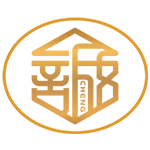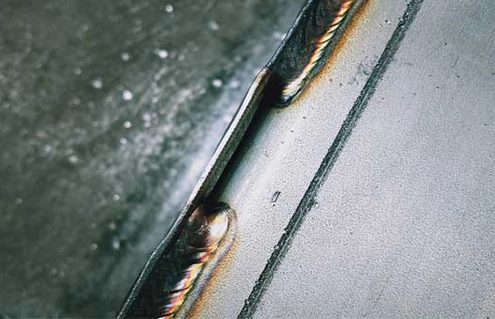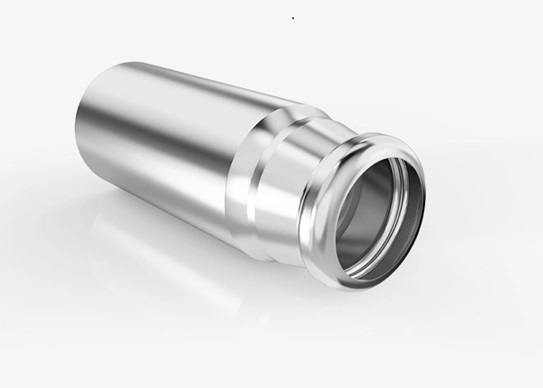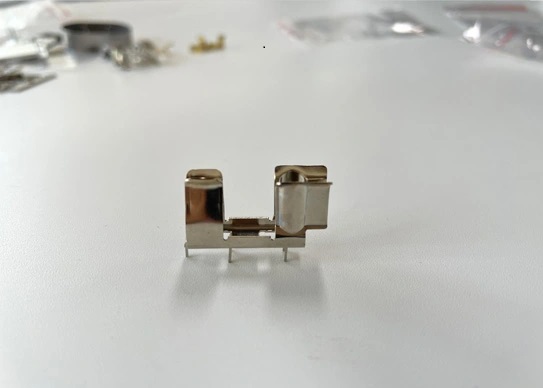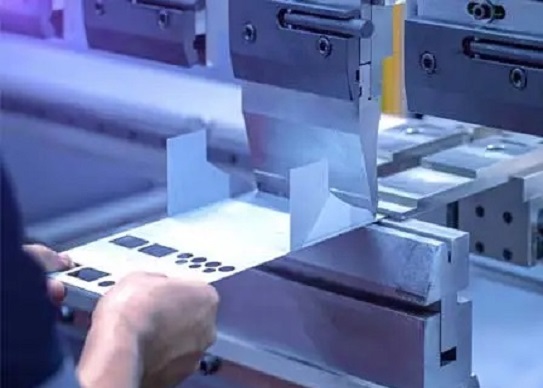1. Alloy - A mixture of two or more metals.
2. Annealing - Heating and cooling a material to relieve stresses.
3. Anodizing - An electrolytic process to coat a metal with a protective or decorative oxide layer.
4. Bending - The process of deforming metal into an angle.
5. Blanking - Cutting a piece out of a sheet of metal to a specific shape.
6. Burr - A rough edge left on metal after cutting or drilling.
7. Carbon Steel - Steel with carbon as the main alloying element.
8. Cast Iron - Iron carbon alloy with high carbon content.
9. Casting - Pouring molten metal into a mold to create a part.
10. Cold Rolling - Deforming metal below its recrystallization temperature.
11. Deburring - Removing the rough edges from a metal part.
12. Deep Drawing - Forming metal into a deep shape by stretching.
13. Die - A tool used to cut or shape material.
14. Die Set - A pair of plates used in a press for punching, bending, or molding.
15. Ductility - The ability of a metal to be stretched without breaking.
16. Electroplating - Depositing a thin layer of metal onto a surface using electricity.
17. Extrusion - Forcing metal through a die to create a long, continuous shape.
18. Ferrous - Metals that contain iron.
19. Flanging - Bending the edges of sheet metal to create a rim or edge.
20. Forge - To shape metal by heating and hammering.
21. Forming - Shaping metal into a specific shape.
22. Galvanized Steel - Steel coated with a layer of zinc to prevent rusting.
23. Hardening - Increasing the hardness of metal through heat treatment.
24. Heat Treatment - Heating and cooling metals to change their physical properties.
25. Hot Rolling - Deforming metal at high temperatures.
26. Hydroforming - Using liquid pressure to shape metal.
27. Iron - A chemical element used as a base metal in steel and cast iron.
28. Laser Cutting - Using a high-powered laser to cut or engrave metal.
29. Lathe - A machine for shaping metal by rotating it against a cutting tool.
30. Machining - Removing material to shape a piece of metal.
31. Malleability - The ability of a metal to be shaped or formed.
32. Metal Spinning - Forming symmetrical parts by rotating a piece of metal against a shaping tool.
33. Milling - Using a rotating cutter to remove material from a piece of metal.
34. Non-Ferrous - Metals that do not contain iron.
35. Oxidation - The chemical reaction of metal with oxygen, often leading to rust.
36. Passivation - Treating metal with a light acid to remove free iron from the surface.
37. Pattern - A model or template used to make a mold for casting.
38. Piercing - Creating a hole in a piece of metal.
39. Punching - Using a press to create holes or indents in metal.
40. Quenching - Rapidly cooling metal to harden it.
41. Rivet - A short metal pin or bolt for holding together two plates of metal.
42. Roll Forming - Continuously bending metal to achieve a specific shape.
43. Rust - The reddish-brown oxide formed on iron or steel by oxidation.
44. Sand Casting - Pouring molten metal into a mold made of sand.
45. Sawing - Using a saw to cut metal.
46. Shearing - Cutting a sheet of metal along a straight line.
47. Sheet Metal - Metal that has been rolled into thin, flat sheets.
48. Slitting - Cutting a roll of metal into narrower rolls.
49. Smelting - Extracting metal from its ore by a process involving heating and melting.
50. Soldering - Joining metals by melting a filler metal into the joint.
51. Stamping - Shaping metal by pressing or punching.
52. Steel - An alloy of iron and carbon.
53. Tempering - Heating and cooling metal to reduce its hardness after hardening.
54. Tensile Strength - The resistance of a material to a force tending to tear it apart.
55. Tolerance - The permissible limit of variation in a physical dimension.
56. Tool Steel - A type of steel used to make tools.
57. Tumbling - Polishing metal by tumbling it with abrasive materials.
58. Welding - Joining metals by heating the surfaces to the point of melting.
59. Wire Drawing - Reducing the diameter of a wire by pulling it through a series of dies.
60. Work Hardening - Hardening of metal by mechanical deformation.
61. Billet - A length of metal that has a round or square cross-section.
62. Brazing - A process where two metals are joined using a filler metal with a melting point above 840°F but below the melting point of the base metals.
63. Carbon Content - The amount of carbon in steel, which can affect its hardness and other properties.
64. CNC Machining - Using computer-controlled machinery to perform various metalworking operations.
65. Coating - Applying a layer, often for protection or aesthetics, to a metal surface.
66. Coining - Stamping metal at great pressure to produce fine detail.
67. Corrosion - The deterioration of metal caused by chemical reactions.
68. Crucible - A container used for melting metal.
69. Cryogenic Treatment - Cooling materials to extremely low temperatures to improve their properties.
70. Die Casting - Forcing molten metal into a mold under high pressure.
71. Drilling - Creating holes in metal using a rotating cutting tool.
72. Dye Penetrant Inspection - A method to detect surface-breaking flaws by bleed-out of a colored or fluorescent dye from the flaw.
73. Electroforming - A method to form metal by electroplating material onto a shape and then removing the shape.
74. Erosion - The process where the surface of metal wears away due to external factors like water or wind.
75. Fatigue Strength - The strength of metal under repeated loading and unloading.
76. Ferromagnetism - The basic mechanism by which certain materials form permanent magnets.
77. Flux - A substance used in brazing and soldering to facilitate the joining process and prevent oxidation.
78. Forging - Shaping metal using localized compressive forces.
79. Galvanizing - Applying a protective zinc coating to steel or iron to prevent rusting.
80. Grinding - Using an abrasive wheel to finely finish or remove material from a workpiece.
81. Hardness - The measure of a metal's resistance to deformation.
82. Ingot - A block of metal, often used as a raw material for further processing.
83. Joining - The process of bringing two metal pieces together, usually by welding or brazing.
84. Lamination - Bonding multiple layers of material together.
85. Lost Wax Casting - A process where a wax model is made, which is then used to produce a mold for casting.
86. Machinability - How easily a material can be machined.
87. Martensite - A hard form of steel crystalline structure.
88. Metallography - The study of the physical structure and components of metals.
89. Nitriding - A heat treatment process that introduces nitrogen onto the surface of a material.
90. Offset Yield Strength - The stress at which a material will deform non-elastically.
91. Peening - A process to impart compressive stresses to the metal's surface using high-speed streams of shot.
92. Polishing - Creating a smooth and shiny surface by rubbing or using a chemical action.
93. Quench and Temper - A heat treatment process to increase the hardness and strength of steel.
94. Reaming - A process to slightly enlarge a hole for a tighter tolerance.
95. Reduction of Area - The difference in cross-sectional area from original stock to the final size.
96. Sandblasting - Cleaning or preparing a surface using a stream of sand ejected by compressed air or steam.
97. Shear Strength - The maximum force a material can withstand under shear loading.
98. Swaging - A process to form a closely fitting joint by forging or extrusion.
99. Temper Brittleness - The reduction in toughness of alloy steels when tempered in a specific range.
100. Tooling - The process of designing and engineering the tools necessary for a manufacturing process.
101. Ultrasonic Testing - A testing method that uses high-frequency sound waves to detect flaws or measure material thickness.
102. Vickers Hardness Test - A test to measure a material's hardness by pressing a pyramid-shaped diamond into its surface.
103. Water Jet Cutting - Using a high-pressure stream of water, sometimes with abrasives, to cut materials.
104. Yield Strength - The stress at which a material begins to deform plastically.
105. Zinc Plating - Applying a thin zinc coating to metal for corrosion protection.
106. Age Hardening - A process that increases the hardness and strength of certain alloys by heating and then cooling.
107. Bainite - A phase in steel consisting of ferrite and carbide.
108. Burnishing - Polishing by rubbing.
109. Chamfer - A beveled edge.
110. Cladding - Applying a layer of metal onto another metal for protection or aesthetics.
111. Decarburization - The loss of carbon from the surface of an alloy due to heating in an environment that reacts with carbon.
112. Ductile Iron - A type of cast iron known for its toughness and strength.
113. Eddy Current Testing - A non-destructive test method that uses electromagnetic induction to detect flaws in conductive materials.
114. Ferrite - A phase in steel and other alloys, it's a soft, magnetic component.
115. Gauge - A standard or scale of measurement.
116. Hardenability - The capability of steel to be hardened through the formation of martensite.
117. Impact Test - A test to measure a material's resistance to impact or shock.
118. Jig - A device used to guide tools or to hold work in place.
119. Knurling - A manufacturing process that produces a patterned texture on a metal's surface, typically for grip.
120. Laser Welding - Using lasers to join pieces of metal.
121. Magnetic Particle Inspection - A non-destructive test method to detect surface and near-surface flaws in ferromagnetic materials.
122. Normalizing - Heating steel or iron and then cooling in air to relieve internal stresses and achieve a uniform grain structure.
123. Oxy-Fuel Cutting - A process that uses oxygen and a fuel gas to cut through metals.
124. Pearlite - A layered structure in some steels, resulting from the transformation of austenite at relatively low temperatures.
125. Quench Crack - A crack induced by the rapid cooling or quenching of certain metals.
126. Resistance Welding - A welding process that joins metals by applying pressure and passing current through the metal areas being joined.
127. Scale - An oxide layer on the surface of metals formed during hot working or during high-temperature exposure.
128. Tack Weld - A small weld used to temporarily hold parts together before final welding.
129. Ultrahigh Carbon Steel - Steel with a carbon content ranging from 1.25% to 2.0%.
130. Vacuum Arc Remelting - A secondary melting process used to refine steels and other alloys.
131. Workpiece - The item being worked on or manufactured.
132. X-Ray Inspection - A non-destructive test method that uses X-rays to inspect the internal structure of a component.
133. Young's Modulus - A measure of the stiffness of a material, or the material's elastic modulus.
134. Zinc Die Casting - The process of casting a molten zinc alloy into a die to create a shape.
135. Autogenous Welding - Welding without the addition of filler metal.
136. Broaching - A machining process that uses a multi-point cutting tool called a broach to remove material.
137. Case Hardening - A heat treatment process that produces a hard surface layer on steel, while maintaining a softer core.
138. Dendritic Structure - A tree-like pattern observed in the solidified structure of some metals and alloys.
139. Electrochemical Machining (ECM) - Removing metal by an electrochemical process.
140. Fillet Weld - A weld of roughly triangular cross-section joining two surfaces at right angles.
141. Galvanic Corrosion - Corrosion resulting from the electrical connection between two different metals or alloys in a conductive solution.
142. Hobbing - A machining process for making gears, splines, and sprockets.
143. Interstitial Alloy - An alloy where certain atoms occupy the interstices (gaps) between the main metal atoms.
144. Jominy Test - A test to measure the hardenability of steel.
145. Keyseat - A slot in a shaft to fit a key which prevents relative rotation of the shaft and the part keyed to it.
146. Lapping - A fine finishing process using loose abrasives between the workpiece and a lapping plate.
147. Matrix - The continuous phase in which particles or fibers in composite materials are embedded.
148. Nodular Iron - Another name for ductile iron where the graphite is present as tiny balls or nodules.
149. Open Die Forging - Forging between flat or simple contoured dies without completely restricting the flow of the material.
150. Passivation - A process that makes the surface of metals, such as stainless steel, more passive or less reactive with the environment, usually by the formation of a thin oxide layer.
151. Quenching Media - Substances like water, oil, or air used to cool a material rapidly during the quenching process.
152. Rivet - A short metal pin or bolt used to join two pieces of metal together.
153. Slag - A byproduct, often seen as waste, resulting from the smelting or melting of metal ore.
154. Tensile Strength - The maximum amount of tensile stress a material can withstand without breaking.
155. Ultrasonic Cleaning - A cleaning process that uses ultrasonic waves in a cleaning solution or solvent to remove contaminants from parts.
156. Vanadium - An element used as an additive in steel to increase strength, toughness, and wear resistance.
157. Weld Pass - A single progression of welding along a joint. Multiple passes may be needed to fill a joint.
158. Xenon Flash - A tool used in high-speed photography to capture images of processes like welding arcs and plasma jets.
159. Yield Point - The stress at which a marked increase in deformation occurs without an increase in load.
160. Zirconium - An element often used in alloys for its high resistance to corrosion.
161. Annealing - A heat treatment process that alters a material's physical and sometimes chemical properties to increase its ductility and reduce its hardness.
162. Blanking - A stamping process that cuts a shape out of a metal sheet.
163. Cold Working - Deforming metal below its recrystallization temperature, often to increase its strength.
164. Dross - Impurities that rise to the surface of molten metal.
165. Electroplating - A process that uses electric current to reduce dissolved metal cations to form a coherent metal coating on an electrode.
166. Ferrous - Metals that contain iron, such as steel or cast iron.
167. Galling - A form of wear caused by the adhesion between two sliding surfaces.
168. Hot Rolling - The process of shaping metal at elevated temperatures.
169. Inclusions - Impurities in metal, often oxides, sulfides, or silicates.
170. Joggle - A small offset in a material to allow for overlap or clearance when joining parts.
171. Killed Steel - Steel that has been deoxidized with silicon, manganese, or aluminum to reduce the oxygen content to a minimum.
172. Laser Cutting - A process that uses a high-power laser to cut materials.
173. Malleability - The ability of a metal to be shaped or bent without breaking.
174. Nickel - A metallic element used in various alloys to provide increased strength, corrosion resistance, and other properties.
175. Oxidation - A chemical reaction where a material reacts with oxygen, often resulting in corrosion.
176. Piercing - A process to produce a hole in a material.
177. Rack Plating - An electroplating process where parts are hung on a rack and then submerged in the plating solution.
178. Sintering - A process of compacting and forming a solid mass of material with heat or pressure without melting.
179. Tumbling - A finishing process where parts are placed into a barrel with abrasive media and rotated to achieve a desired finish.
180. Upsetting - A forging process that increases the diameter of a workpiece by compressing its length.
181. Vise - A mechanical apparatus used to secure an object to allow work to be performed on it.
182. Wrought Iron - An iron alloy with very low carbon content and fibrous inclusions, known for its malleability.
183. Extrusion - A process used to create objects of a fixed cross-sectional profile by pushing material through a die.
184. Yield-to-Tensile Ratio (Y/T) - A ratio that compares the yield strength to the tensile strength of a material.
185. Zinc Whiskers - Thin, hair-like growths of zinc that can form on surfaces electroplated with zinc.
186. Abrasion - The process of scuffing, scratching, wearing down, or rubbing away through friction.
187. Burr - A rough edge or ridge left on metal after cutting or drilling.
188. Carbide - A compound composed of carbon and a less electronegative element, often used for cutting or drilling tools.
189. Differential Hardening - A process where different areas of a workpiece are hardened to different extents.
190. End Mill - A type of milling cutter, a cutting tool used in milling applications.
191. Flame Hardening - A process where the surface of a part is hardened using an oxy-gas flame.
192. Gun Drilling - A deep hole drilling process to make deep holes with a high depth-to-diameter ratio.
193. Honing - A finishing process used to improve the geometry and surface finish of a hole.
194. Interstitial Free (IF) Steel - Steel that is made almost free from interstitial elements like carbon and nitrogen to enhance formability.
195. Joule Effect - Heating produced by the flow of electric current through a conductor.
196. Knockout - A process or device used to remove a pattern or core from a casting.
197. Lost Foam Casting - A casting method in which a foam pattern is used to form the mold, which is then evaporated when molten metal is poured.
198. Microstructure - The small scale structure of a material, which can be viewed under a microscope.
199. Neutral Flame - A flame with a balanced mixture of fuel and oxygen, used in oxy-fuel processes.
